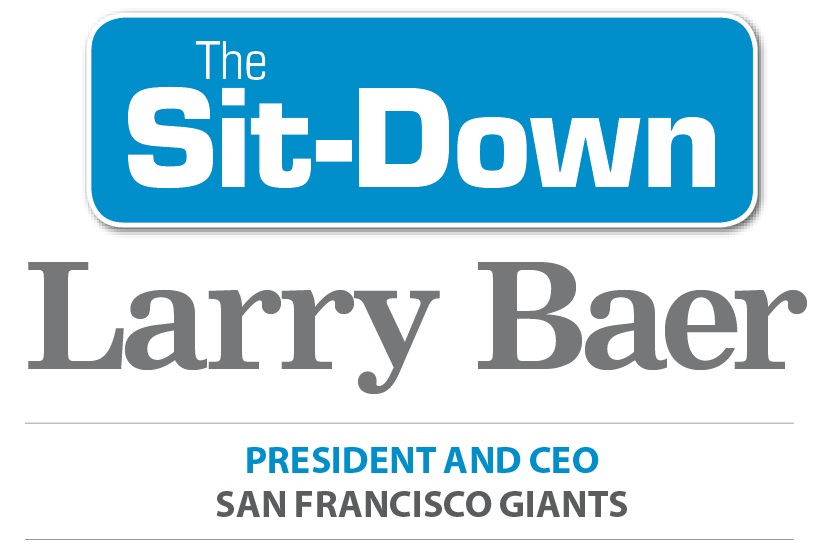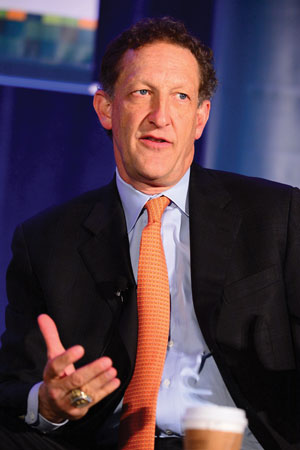
Iremember Peter Magowan, who I partnered with for 17 years, when we acquired the team in 1993. Magowan said that if you have 100 decisions a week and you hit on 87 percent, you’re doing all right. But if you make four decisions a month and hit on all four, you’re letting a lot of opportunities pass by.
The way we look at it is how do we deal with the scale economics of not being New York, L.A. or Chicago? Because we’re not going to have as many eyeballs on television and we’re not going to drive the television dollars, dollar for dollar for sure. So our answer to that is to get in some other businesses that could be compelling.
 |
Photo by: RICH SCHMITT
|
For us a real opportunity is real estate, and the opportunity is to develop in a hot market and to develop a new project that can create a new neighborhood and new community around our ballpark. Tough to do in California, lots of titlement issues and political issues, but we’re well on our way to making that happen [with the Mission Rock mixed-use project].
Rob Manfred has done an outstanding job.
I take the approach that you’re never better than your first 100 days on a job. Because you come in without the blinders and you just go at it. And you can ask questions that might be viewed two years from now as stupid questions or ill-informed questions, but you have permission to do that.
A committee I’m overseeing is looking at a bunch of issues, including a 154-game schedule vs. a 162-game schedule. The revenue impacts, there’s a collective-bargaining agreement coming up, so how can all of that work? Could you change the postseason around a little bit?
I don’t think [the Giants] wrote the book on how to relate to youth and fill a ballpark. But … I think there’s a feeling of accessibility between our fans and our team and our players.
Over the years we’ve had players who have had very popular nicknames. Animal nicknames! What better way to appeal to youth than bring in the animals, make it a zoo.
So, you know, Pablo Sandoval was the Panda, and Brandon Belt is the Baby Giraffe, and we have Tim Lincecum, the Freak, and Brian Wilson, the Beard.
One thing we’ve learned is really critical is that it has to develop organically. So you don’t say, “Oh, we’re going to come up with this name, the Freak, for Tim Lincecum.” People held signs, people came up with it.
What our job is, and I’m sure all of you are in this world, is to take the germs of good ideas which come organically from players, fans, media and push it out there and exploit and expand it.
We like to try to create a feeling where it’s kind of like a carnival. We have a race here in San Francisco called the Bay to Breakers, and people dress up. … So we feel like we have an opportunity to have 81 versions of the Bay to Breakers in our ballpark.
In the mid- [to] early ’90s, Candlestick [Park] and Dodger Stadium were about the same age. Candlestick felt like it was 75 years old, and they were both 35 years old at that point. … Why? Because the Dodgers did a great job of maintaining Dodger Stadium.
We’ve done a series of studies with Populous, the ballpark architect, on what structurally can we do [at AT&T Park], much of it behind the scenes that the fan won’t see, but what keeps it fresh. You know, with coats of paint, with laminate. … We’re in a maritime environment, so there’s more wear and tear in the facility, salt air.
We feel like this is a Disney-type approach. … Every year we feel like there has to be something new in the ballpark. There’s a new attraction.
We have a really good group of folks who brainstorm what can we do, and you can’t do it in January. You have to do it a year out.
I’ve talked to Larry [Lucchino] about [Boston’s Olympic bid] and some other folks in Boston, and I hope they can make it happen. They have some challenges, but I think everything we do in sports, since it’s so high profile, image is important. And there’s obviously some imaging problems in the early stages of the bid.
They’ve got to make the case for why it’s a net positive. I believe the Olympics could be a huge net positive to any American city if done the right way. And it comes down to infrastructure improvements, it comes down to legacy.





